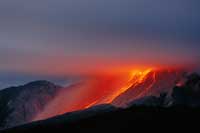Volcano Island, By David Lea and Professor Steve Sparks Inspire article
If you ask Italian school students to name an active volcano in their country, they will have a wealth of names – such as Vesuvius, Etna, Stromboli and all the other Aeolian Islands – to choose from.

Ask students in France to name an active French volcano, and they may be able to name volcanoes from the country’s overseas territories, such as Piton de la Fournaise on Réunion island, La Grande Soufrière on Guadeloupe and the infamous Montagne Pelée on Martinique.
A similar question posed to a school pupil in the UK would probably produce a blank stare, however – disbelief that such a thing as an active British volcano even exists.
In 1995, the inhabitants of the beautiful island of Montserrat, a rich and flourishing British overseas territory in the West Indies, realised with surprise that Soufrière Hills, a dormant volcano on the island, had awakened. The capital of the island, Plymouth, was evacuated and later destroyed by volcanic activity in 1997. Of the initial 12 000 inhabitants, 8000 were forced to leave the island, relocating to neighbouring islands, such as Antigua, or distant and cold Britain. The remaining population moved to the undeveloped and more austere northern side of the island. With their economy and infrastructure destroyed, Montserratians learned to live alongside their ash-spewing, earth-shaking and growing volcanic neighbour. Twelve years on, this volcano is still active and still disrupting their lives.
When taught about the rock cycle in Year 8, English students aged 12-13 are sometimes shown extracts from Dante’s Peak, a 1997 Hollywood movie starring Pierce Brosnan. Though Brosnan is a charming and convincing volcanologist in the film, he does study a highly unusual volcano that can produce very low and very high viscosity lava in the same cycle of eruptions. In contrast, the educational documentary Volcano Island presents an accurate scientific picture of what it is like to live in the shadow of a volcano. Describing the story of a real volcano, the film has been created by a volcanologist and an experienced videographer, and is aimed at students who want to learn the scientific aspects of volcanology.
Sponsored by The Royal Society, David Lea, a Montserratian videographer, and Professor Steve Sparks, a world-renowned volcanologist at Bristol University, UK, produced Volcano Island to tell the real story of Montserrat’s misfortune. Available on DVD, it is specifically aimed at secondary-school pupils. Using simple language and the bare minimum of scientific jargon, the film cleverly explains the reason for the presence of a volcano on this particular island. It then describes the volcanic products emitted by the volcano and how they affect the lives of the people living on the volcanic flanks.
The activity of Hawaiian volcanoes is then compared with that of Montserrat. Hawaiian basaltic volcanoes eject a low-viscosity lava, forming dramatic fountains and flows. In contrast, the andesitic volcano on Montserrat extrudes a thick, viscous lava that piles up at the vent, forming a grey dome. When the dome reaches a certain volume and the pressure inside the volcano reaches a certain threshold, the volcano blows its top in a spectacular but dangerous way, forming so-called pyroclastic flows or nuées ardentes. As explained in Volcano Island, pyroclastic flows are very hot and fast-moving currents comprising rocks, ash and gas, which destroy, burn and bury everything in their path. Such flows from Mount Vesuvius in Naples and Mount Pelée in Martinique eradicated Pompeii in 79 AD and Saint Pierre in 1902, respectively. Both events killed thousands of people.
The film explains, in a very concise manner, how scientists monitor the activity of the Soufrière Hills volcano. It shows how the work of the scientists, who try to understand and predict volcanic behaviour, can help politicians decide whether to evacuate certain parts of the island. It also mentions the dreadful eruption of June 1997 in which 19 Montserratians lost their lives. In an emotional interview, a witness of the eruption recalls her experience.
Scientifically, Volcano Island presents a wealth of information on the physical processes acting during this ongoing eruption. Moreover, it also depicts the economic and social disaster that struck the island and its inhabitants. The scientific quality of this movie is strongly reinforced by the amazing footage of eruptions.
Details
Publisher: Price of Paradise
More information about this DVD is available on the Price of Paradise website (www.priceofparadise.com). Alternatively, you can contact David Lea (lead@candw.ms).





